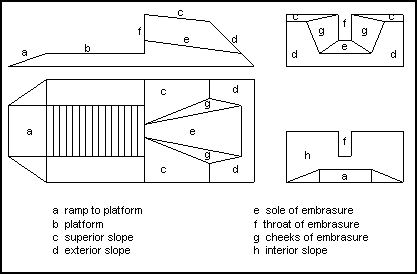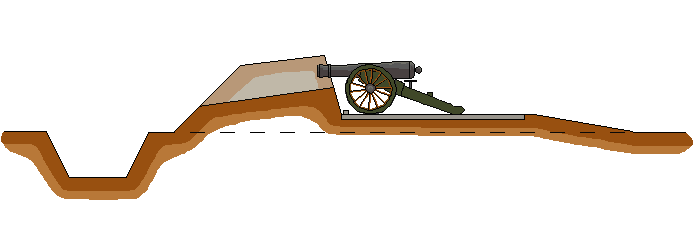Civil War Field Fortifications
Embrasures
Embrasures were weak points that broke the continuity of
a parapet's value as both shelter and obstacle. Enemy fire could penetrate
through an embrasure to the interior spaces of a work and attacking troops
could use them as so many small breaches to pass through the parapet. Embrasures
were designed to minimize these weaknesses by reducing the opening in the
parapet as much as possible while still allowing artillery enough open space
to be able to direct its fire effectively over ground in front of the parapet.
This was accomplished by making embrasures narrow at the throat where
the muzzle of the cannon entered and wide enough at the mouth where embrasures
terminated on the exterior slope to allow cannon to be pointed slightly to
the left and right. The bottoms of embrasures, the soles, were given a downward
angle to allow cannon to depress enough to be able to fire across the crest
of the counterscarp. The soles were generally cut down into the parapet
no more than four feet in order to embrasures' mouths well above the level
of the berme and to maintain as much of the
 lower portion
of the parapet in place as possible to protect the cannon and cannoneers
form enemy fire. The cheeks, or sides, of embrasures were also inclined to
both help them sustain the blast when cannon discharged and to increase the
effective open space within embrasures without further reducing the thickness
of the parapet.
lower portion
of the parapet in place as possible to protect the cannon and cannoneers
form enemy fire. The cheeks, or sides, of embrasures were also inclined to
both help them sustain the blast when cannon discharged and to increase the
effective open space within embrasures without further reducing the thickness
of the parapet.
Embrasures had to be carefully positioned along the line
of the interior crest to allow cannon to participate effectively in a field
work's defense. Their narrowness severly restricted horizontal fields of
fire so they had to be placed to give cannon a direct line of fire toward
a specific target or target area. Placed at a work's salient angles, embrasures
allowed cannon to cover those sectors in front of the salients that could
not otherwise be reached by a direct fire from the faces forming the salient.
When placed on flanking faces or on the faces forming re-entering angles,
embrasures allowed cannon to fire along lines that were parallel to the covered
faces, thus enabling the artillery to attain an enfilade or slanting fire
on attacking enemy troops as they approached the ditch. By the same token,
poorly positioned or inadequately constructed embrasures could render a work's
artillery armament completely ineffective by directing its fire onto unproductive
ground or preventing its fire altogether when the cheeks of embrasures collapsed
onto the soles due to the destructive effects of the cannon's blasting discharge.

Also
See the Detailed Note on Embrasures
Back to Major
Works
Contents
Home Page
Minor Works
Siege Works
Permanent Fortifications
Glossary
Copyright (c) PEMcDuffie 1997, 1998
 lower portion
of the parapet in place as possible to protect the cannon and cannoneers
form enemy fire. The cheeks, or sides, of embrasures were also inclined to
both help them sustain the blast when cannon discharged and to increase the
effective open space within embrasures without further reducing the thickness
of the parapet.
lower portion
of the parapet in place as possible to protect the cannon and cannoneers
form enemy fire. The cheeks, or sides, of embrasures were also inclined to
both help them sustain the blast when cannon discharged and to increase the
effective open space within embrasures without further reducing the thickness
of the parapet.
